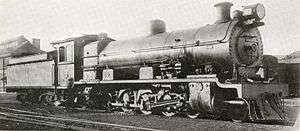1913 in South Africa
The following lists events that happened during 1913 in South Africa.
| |||||
| Decades: |
| ||||
|---|---|---|---|---|---|
| See also: | |||||
Incumbents
- Monarch: King George V.
- Governor-General and High Commissioner for Southern Africa: The Viscount Gladstone.[1]
- Prime Minister: Louis Botha.
- Chief Justice: John de Villiers, 1st Baron de Villiers
Events
- May
- South Africa's first flying school opens in Kimberley to train pilots for the South African Aviation Corps.
- June
- 19 – The Natives Land Act is passed, limiting land ownership for blacks to black territories.
- November
- 6 – Mohandas Gandhi is arrested while leading a march of Indian miners in South Africa.
- Unknown date
- The City of Greater Cape Town is formed by the union of Central Cape Town, Green Point and Sea Point, Woodstock, Maitland, Mowbray, Rondebosch, Claremont and Kalk Bay.
Births
- 6 April – A. P. Mda, co-founder of the African National Congress Youth League (ANCYL) and Pan Africanist Congress of Azania (d. 1993)
- 9 December – Gerard Sekoto, artist. (d. 1993)
Deaths
- 12 March – Christoffel Cornelis Froneman, commandant of the Orange Free State and founder of Marquard. (b. 1846)
- 30 April – Daniël Jacobus Erasmus, acting state president of the Zuid-Afrikaansche Republiek. (b. 1830)
- 16 November – Abraham Fischer, Prime Minister of the Orange River Colony. (b. 1850)
Railways
Railway lines opened
- 5 March – Cape – Vredenburg to Saldanha (Narrow gauge), 9 miles 65 chains (15.8 kilometres).[2]
- 15 May – Free State – Arlington to Senekal, 27 miles 30 chains (44.1 kilometres).[2]
- 15 July – Cape – Butterworth to Idutywa, 26 miles 74 chains (43.3 kilometres).[2]
- 6 August – Cape – George to Oudtshoorn, 45 miles 30 chains (73.0 kilometres).[2]
- 3 November – Cape – Graafwater to Kleipan, 22 miles 67 chains (36.8 kilometres).[2]
- 3 November – Free State – Reitz to Marsala, 28 miles 69 chains (46.4 kilometres).[2]
- 10 November – Transvaal – Nelspruit to Sabie, 55 miles 36 chains (89.2 kilometres).[2]
- 1 December – Natal – Greytown to Ahrens, 19 miles 70 chains (32.0 kilometres).[2]
- 5 December – Transvaal – Bandelierkop to Lilliput, 83 miles 33 chains (134.2 kilometres).[2]
- 15 December – Natal – Tendeka to Piet Retief (Transvaal), 76 miles 35 chains (123.0 kilometres).[2]
Locomotives
- Two new Cape gauge locomotive types enter service on the South African Railways (SAR):
- The New Cape Central Railway places three Cape 7th Class 4-8-0 Mastodon type locomotives in service.[3][4][5]
Sports
Rugby
- 11 January – The South African Springboks beat the French Les Tricolores 38–5 in Bordeaux, France.
gollark: But I haven't and mine might be really good.
gollark: But you don't even know the policies of each candidate yet.
gollark: You could do 2 of 3 admins or something.
gollark: Just give ABR perms to do common tasks or handle some emergencies
gollark: Precisely.
References
- Archontology.org: A Guide for Study of Historical Offices: South Africa: Governors-General: 1910-1961 (Accessed on 14 April 2017)
- Statement Showing, in Chronological Order, the Date of Opening and the Mileage of Each Section of Railway, Statement No. 19, p. 187, ref. no. 200954-13
- Paxton, Leith; Bourne, David (1985). Locomotives of the South African Railways (1st ed.). Cape Town: Struik. pp. 38–39, 46–48, 56–57. ISBN 0869772112.
- Holland, D.F. (1971). Steam Locomotives of the South African Railways. 1: 1859–1910 (1st ed.). Newton Abbott, Devon: David & Charles. pp. 78–80. ISBN 978-0-7153-5382-0.
- Pattison, R.G. (1997). The Cape Seventh Class Locomotives (1st ed.). Kenilworth, Cape Town: The Railway History Group. pp. 15–16. ISBN 0958400946.
This article is issued from Wikipedia. The text is licensed under Creative Commons - Attribution - Sharealike. Additional terms may apply for the media files.
.jpg)
_ex_NCCR_10.jpg)
